- Premium features included
- No hidden costs or usage limits
- Scale from startup to enterprise

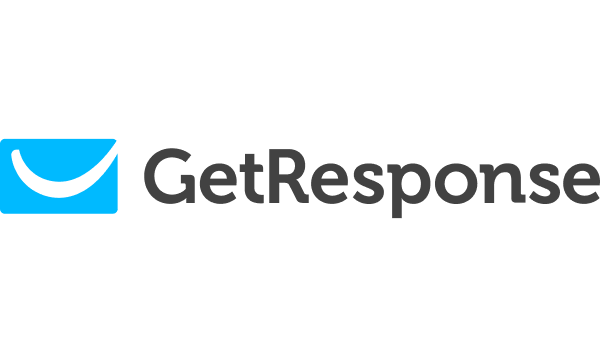
What stands out about GetResponse is the way it’s positioned—and I’m not only talking about it being an email marketing automation software. It’s built to serve freelancers, small online businesses, and content creators, all who can benefit from its features once they’re ready to go beyond the limitations of basic email marketing tools.
What truly sets this platform apart is that it’s genuinely all-in-one: you’re getting advanced marketing automation workflows, conversion funnels, webinar capabilities, website builder, and even AI-powered campaign tools wrapped in a clean, user-friendly package.
But is being a well-rounded platform enough in today’s market to win over marketers looking for a tool that will tick all their boxes? Read this GetResponse review and find out.
Founded by (at the time) 18-year-old Simon Grabowski in his attic in 1998, GetResponse is a comprehensive email marketing platform built to help businesses grow their audience, nurture leads, and drive sales through multiple channels.
What began as a simple autoresponder grew into a respected platform that combines email marketing, automation and sales funnels together, so that teams can manage their campaigns without juggling multiple dashboards.
Recently, GetResponse has stepped up its innovation with an AI-powered email generator that handles both design and copy, making it easier to create polished, high-performing emails in minutes. The email marketing software now delivers AI-driven product recommendations that analyze visitor behavior, preferences, and buying habits to suggest the right products at the right time.
GetResponse doesn’t mess around with its email marketing campaign tools. You can send one-off broadcasts, set up autoresponder sequences, or create campaigns triggered by specific times or behaviors.
I loved that they go beyond just slapping a first name in the greeting—you can personalize based on custom fields, tags, and how subscribers have interacted with previous content.
Their predictive scheduling is pretty clever as well, although not too different from competitors’ predictive sending features. GetResponse’s “Perfect Timing” tool helps analyze when each subscriber typically opens emails and sends them accordingly.
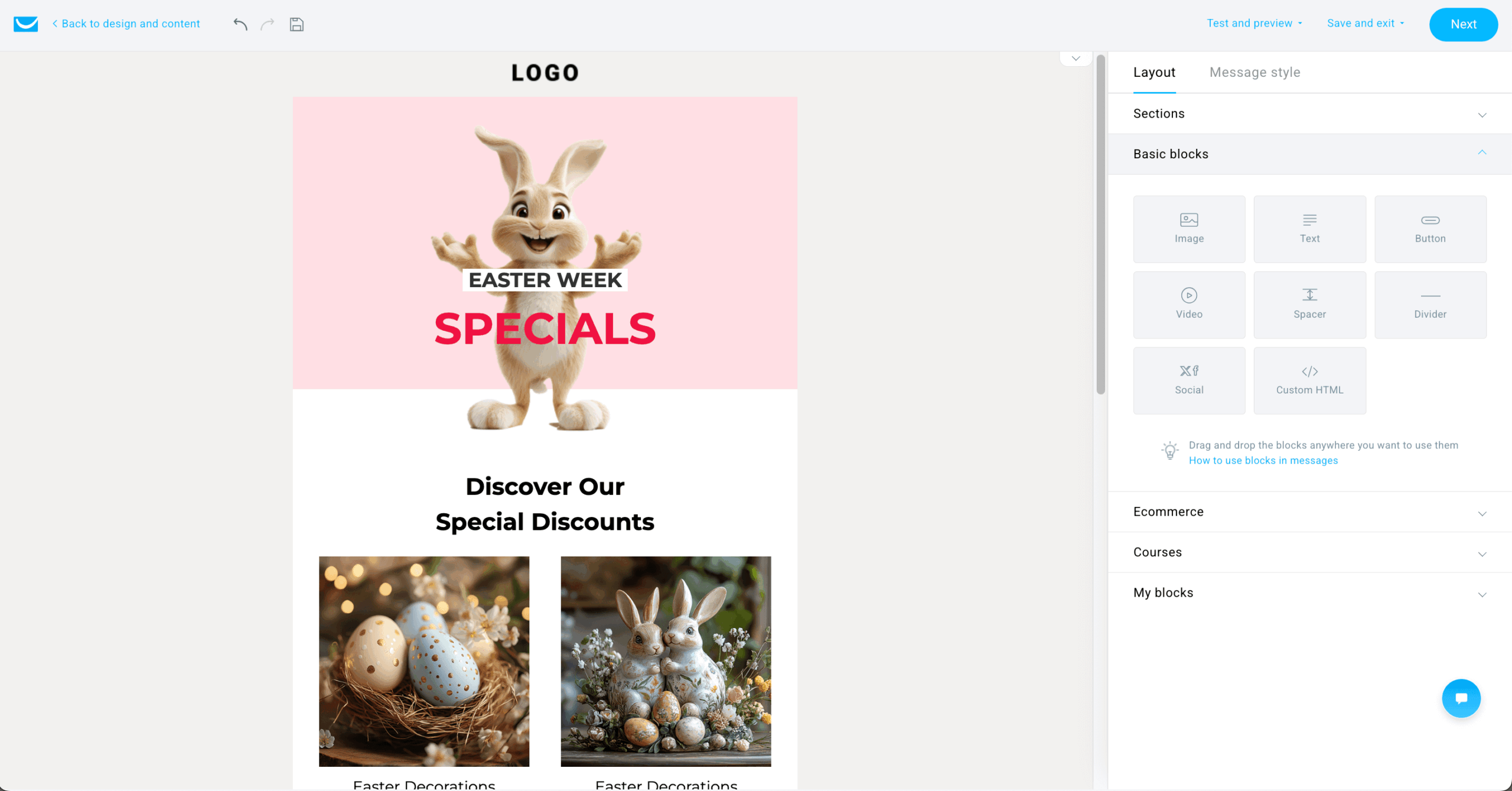
Designing emails in GetResponse feels pretty seamless thanks to its drag-and-drop editor. I could quickly build layouts with text, images, buttons, and product blocks. Saving reusable sections has been a real time-saver too.
The built-in mobile preview makes it easy to adjust how each element looks on different devices, which helps keep everything consistent.
That said, I’ve had to do a little extra tweaking for spacing and alignment at times. Advanced customization like custom CSS is also limited to higher-tier plans. Still, for most campaigns, GetResponse email editor is intuitive and efficient.
When it comes to email templates, GetResponse doesn’t disappoint. It offers 150+ email templates, ranging from newsletters and promos to welcome emails. So it’s always easy to get started.
I really like the variety and flexibility of GetResponse’s templates, though I have noticed some of them look a little dated and could use a fresh coat of paint. When I’ve wanted deeper customization, I’ve sometimes had to dive into HTML or upgrade to a higher-tier plan—which might be frustrating if you’re picky about design or have a limited budget.
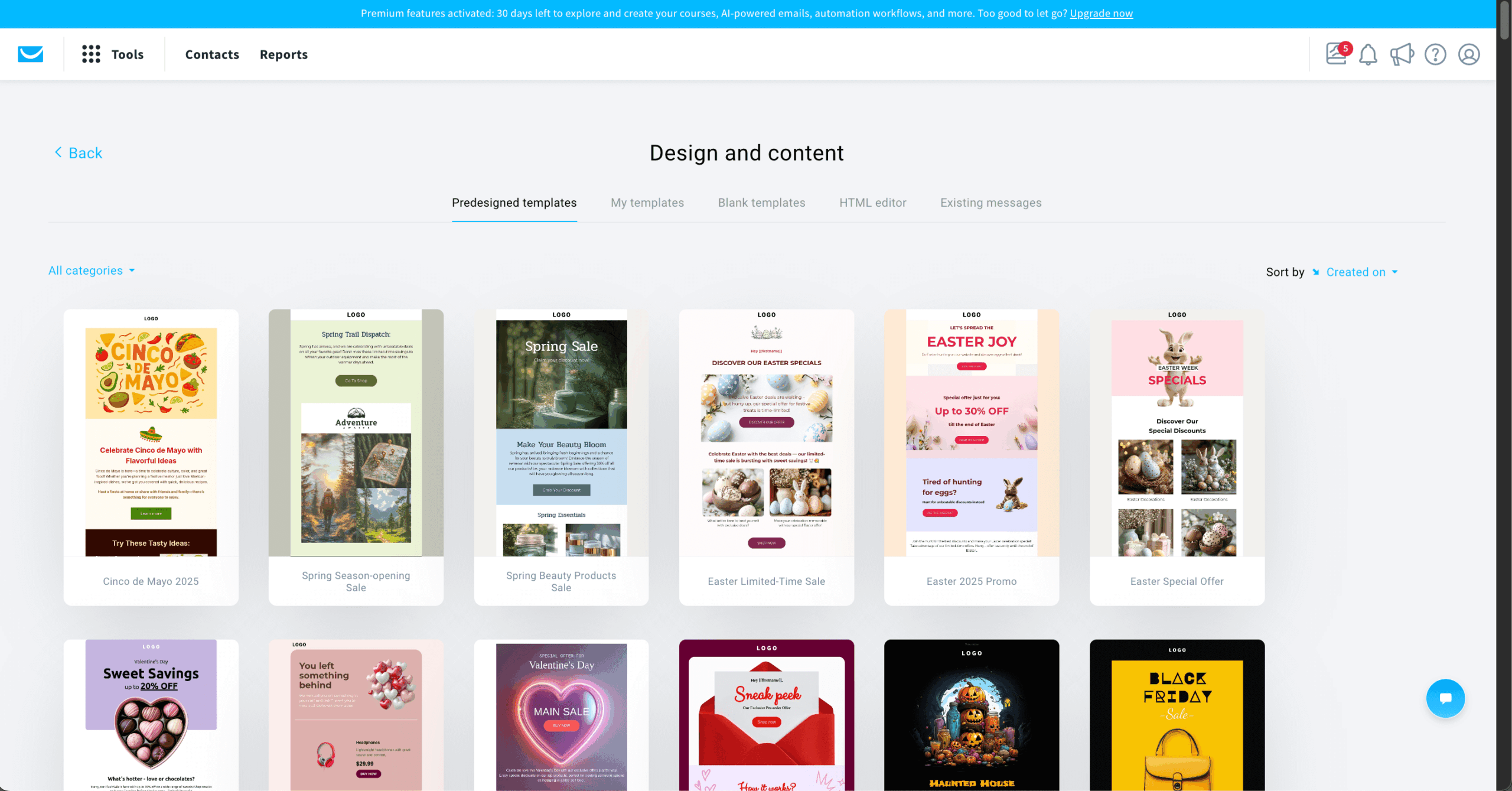
I’d argue that automation is where GetResponse really shines, unfortunately most of their advanced marketing automation tools are hidden behind higher-tier plans. Still, their visual workflow builder is intuitive and lets you create multi-step sequences triggered by a variety of events.
You’ll also find over 40 pre-made marketing automation templates (e.g., abandoned shopping carts, win-back campaign, course promotion) ready at your disposal, which is another point for GetResponse.
What makes its automation great is the ability to apply filters, delays, and conditional logic so subscribers follow personalized paths based on how they engage. I especially like that the emails in these workflows can include dynamic content driven by tags and engagement data—though you’ll want to be prepared for a bit of a learning curve when setting it all up.
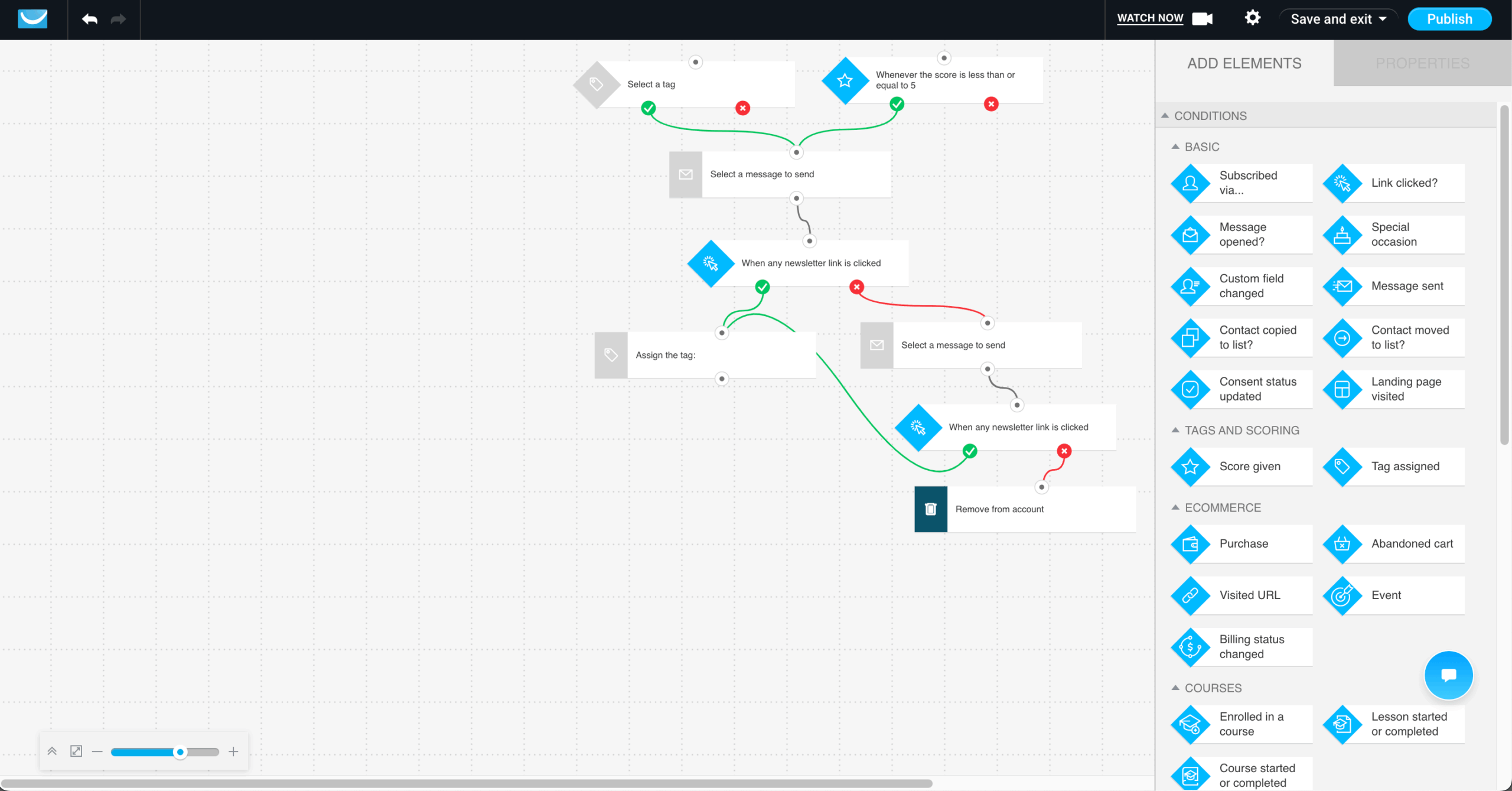
In my experience, GetResponse has been solid when it comes to deliverability. I’ve generally seen its inbox placement averaging no less than 89%, but I know from independent tests that the overall average is closer to 84%. In other words, expect a portion of emails to hit spam folders, no matter what your ISP or how well-maintained your list hygiene is.
I like that they give you tools and guidance to improve results, including spam score checks, FBL access, bounce suppression, IP warmup tips, and list cleaning integrations. There’s even a sender score dashboard to monitor reputation. Setup takes a bit of effort, and I wish reporting showed spam-folder placement more clearly.
GetResponse’s webinar tools are surprisingly capable for an all-in-one platform. The no-download Webinar Builder makes setup quick, and I love that registration pages, email invites, and reminders are built right in. During live sessions, I can share my screen, run polls, use a whiteboard, and even drop call-to-action buttons to drive signups or sales on the spot.
That said, attendee limits depend on your plan, and you can only run one webinar at a time unless you upgrade. For really large, polished productions, a dedicated webinar platform might offer more control—but for most marketing and lead-nurture use cases, this feels like a solid, well-integrated solution.
I’ve found GetResponse’s Conversion Funnel builder a great way to pull all the pieces of a campaign together. You can pick a prebuilt funnel template—whether it’s for a lead magnet, product launch, or webinar—and it walks you through each step.
I also liked that you can track performance at each stage, see where leads drop off, and add upsells or abandoned cart follow-ups. The Conversion Funnel makes it easy for your sales team to follow up with leads and close deals faster.
That said, the funnel structure can feel a bit rigid compared to dedicated funnel tools, and some ecommerce features require higher-tier plans or additional setup. But for small to mid-sized businesses that want a simple, guided way to build complete sales funnels, GetResponse will do just fine.
Signup forms are a weak spot for many email marketing platforms, but GetResponse has been a pleasant surprise. They give you plenty of options, from simple embedded forms to timed popups and even exit-intent triggers. All forms can be embedded directly into pages built with the website builder, keeping your design consistent.
The drag-and-drop editor makes them easy to customize, and I like that you can add custom fields or tweak the design without much effort.
Even on the lower plans, you get access to basic forms, which is great for starting out. That said, some of the templates look a little dated, and if you want advanced display rules or behavior-based triggers, you’ll need to be on a higher-tier plan. I’ve also hit some styling limits when trying to fully match my site’s design.
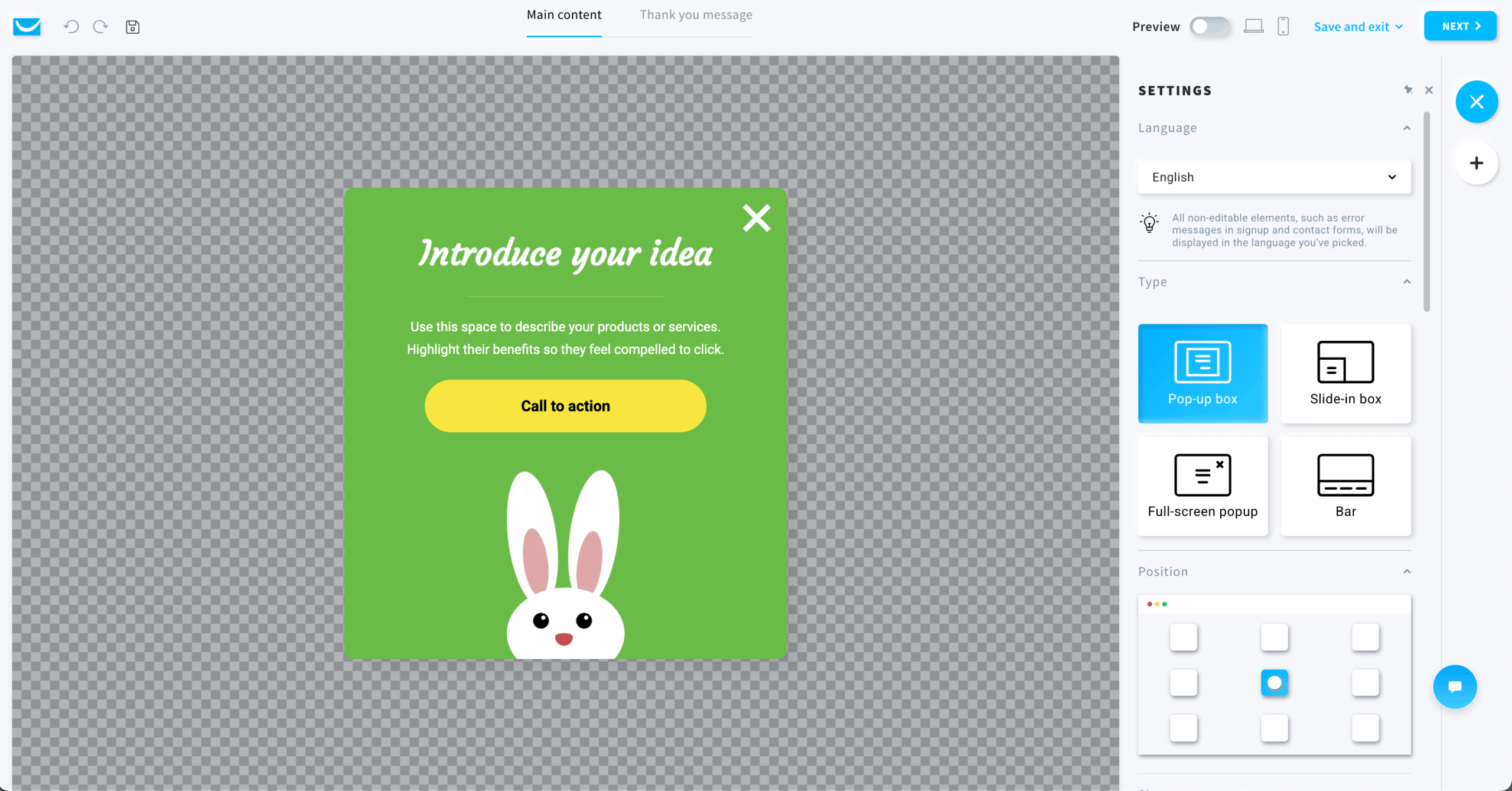
Besides email automation, landing pages are the building blocks of any email marketing automation platform, and GetResponse handles them rather well. You can build custom landing pages with their drag-and-drop editor in the website builder tool or pick from 200+ templates to get started. However, I found that quality can vary a bit between templates.
The signup forms are flexible, though. You can embed them on your own domain, display them as popups based on timing or exit intent, and even apply tags or segment new subscribers—provided you’re on a plan that supports advanced automations.
Another thing I want to applaud in my GetResponse’s website builder review is the built-in device preview, which lets you see exactly how your page will look on mobile and desktop—perfect if your audience uses a mix of both.
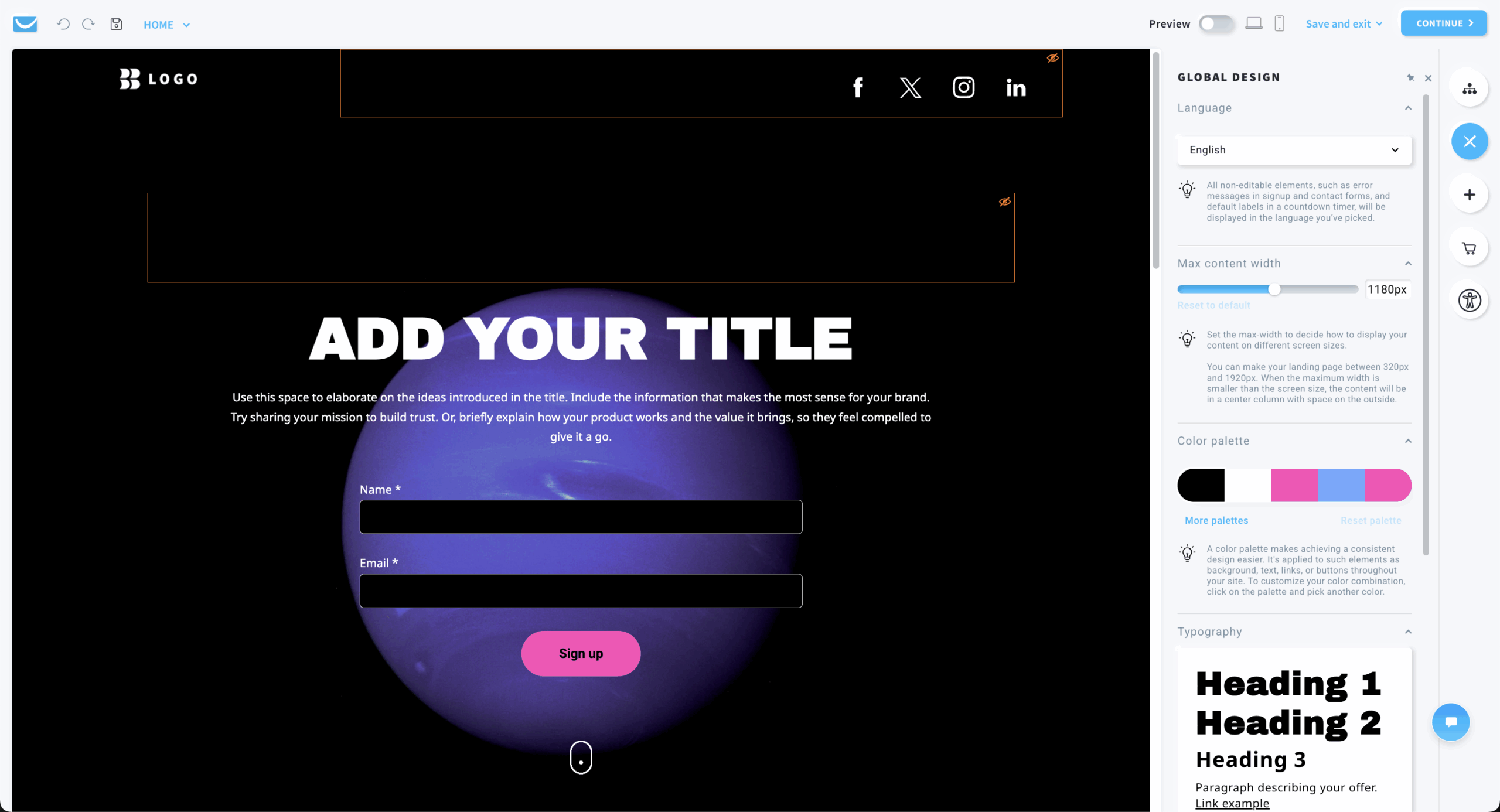
GetResponse gives you plenty of control over audience targeting and personalization. I could create dynamic segments using filters like email engagement, purchase history, location, and any custom fields I’ve set up.
These segments power highly personalized campaign content through tags, conditional logic, and behavior tracking—though some of the more advanced triggers (like purchase events, custom site actions, or abandoned cart tracking) and segmentation options are only available on higher-tier plans.
I appreciated that personalization extends beyond just the body text as well. You can also display dynamic content based on tags and field values, which is non-negotiable in my books
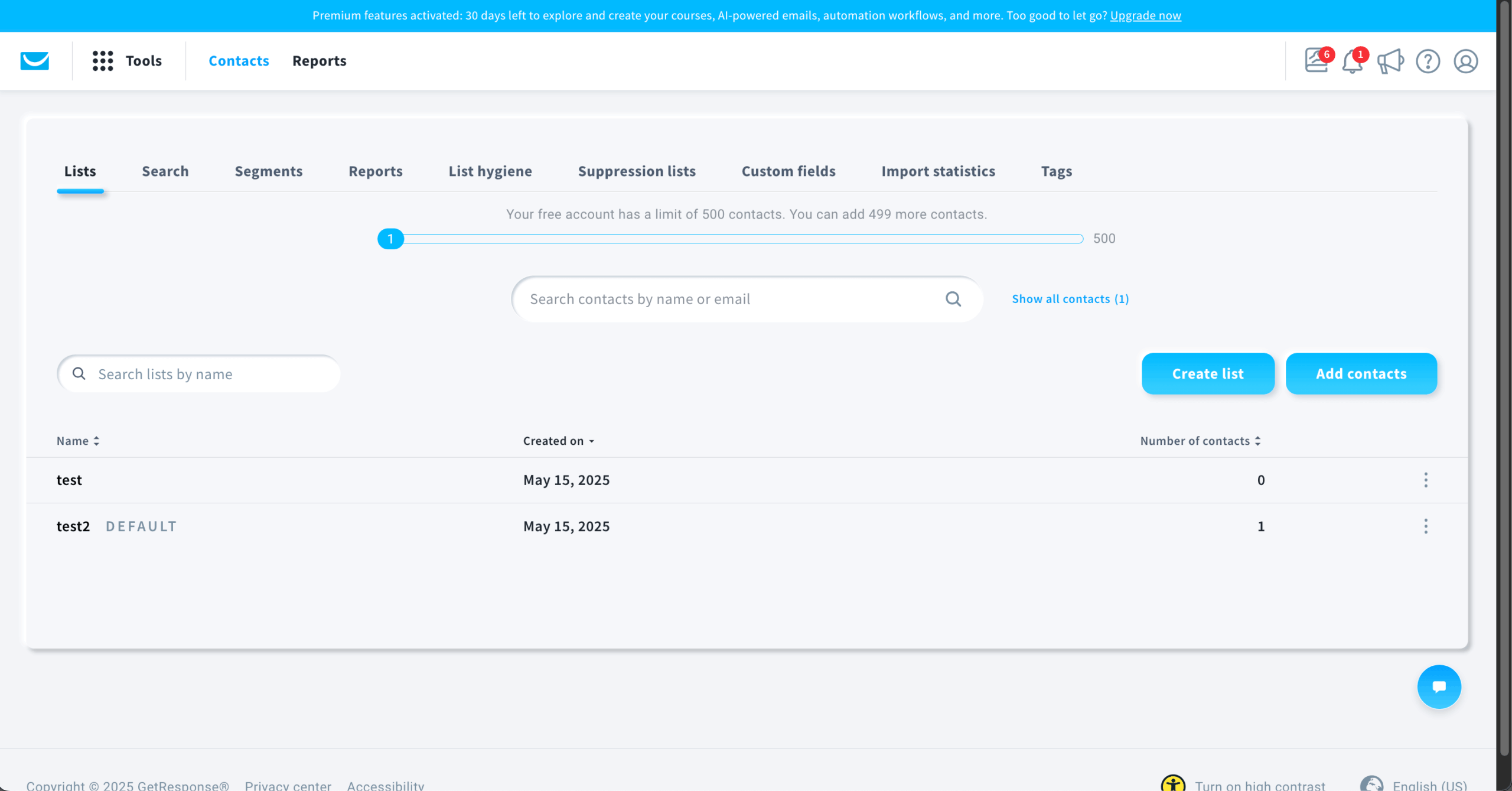
GetResponse account connects with over 170 extensions across ecommerce, webinars, payments, and analytics, which allows it to fill in the gaps in the platform’s built-in toolkit. It’s worth noting that GetResponse isn’t a complete CRM solution, so if you need full-fledged customer relationship management, you’ll likely want to integrate GetResponse with tools like Zoho or Agile CRM.
Integrations with popular ecommerce solutions like Shopify, WooCommerce, PayPal, and Salesforce sync customer behavior and transaction data in real-time.
Their REST API provides developers full access to subscriber records, campaign triggers, and engagement metrics. This flexibility allows you to launch, pause, or even personalize content inside the website builder based on customer data.
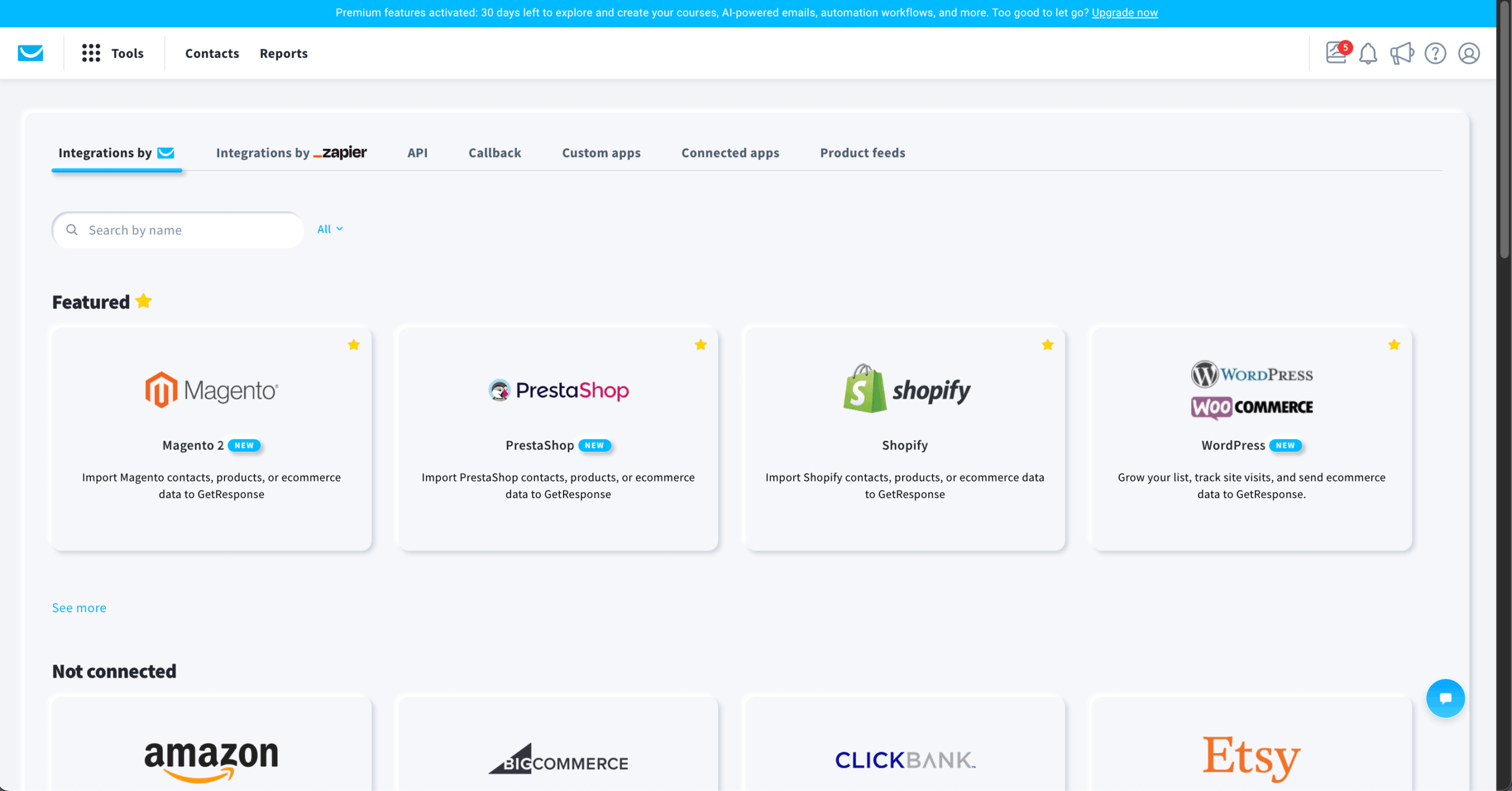
GetResponse’s reporting gives you a pretty comprehensive view of how your campaigns are performing. Each campaign, whether it’s a one-off broadcast, sequence, or triggered flow, includes detailed metrics on opens, clicks, bounces, unsubscribes, and goal completions.
What I find most useful is being able to segment performance by device, location, subscriber behavior, or custom tags. This provides a granular view of which content works best with different audience groups. Beyond opens and clicks, you also get sales tracking to measure revenue generated by each campaign.
Another great thing about GetResponse’s reporting tools is that you can export reports or connect data to third-party analytics platforms, such as a native Google Analytics integration, if you need deeper insights—though, I wish the dashboards were more customizable.

In my experience, GetResponse’s customer support goes beyond just troubleshooting—they’re actually helpful with strategic guidance as well.
Available via 24/7 email and live chat support, the support team can help with setting up segmented campaigns, refining personalization, optimizing send times, and interpreting analytics. One thing to notice, though, is that there’s no phone support, which might be a deal-breaker for businesses that work in high-stakes situations.
In my experience with GetResponse support, they walked me through configuring A/B tests and setting up behavioral triggers. The multilingual support is a nice touch for international users, and there’s an extensive knowledge base full of tutorials, webinars, and walkthroughs if you ever need a hand with their website builder tool and whatnot.
Free
Starter
Marketer
Creator
Enterprise
$0
$15
per month
$52
per month
$60
per month
Custom pricing
No free plan available.
GetResponse is a great all-in-one tool if you want to run webinars, build funnels, and send emails without juggling multiple platforms. Its email deliverability is consistently strong, so your messages actually land in inboxes. The “Perfect Timing” and time zone scheduling features are super handy for boosting open rates automatically.
With GetResponse you also get powerful segmentation and dynamic content tools to keep things personalized and relevant. Plus, their 24/7 live chat support (available in multiple languages) is fast and helpful. Overall, it’s a solid, easy-to-use platform for anyone looking to simplify marketing and get better results with less hassle.
While GetResponse is powerful, it’s not perfect. Some parts of the interface feel a bit dated and can be unintuitive at first. Pricing also jumps up pretty quickly as your contact list grows, which can be frustrating for small businesses on a budget. Setting up more advanced workflows takes a bit of a learning curve, so expect to spend some time figuring things out.
There are also fewer native integrations compared to some competitors, which might mean relying on third-party tools. And while the templates work fine, some could use a refresh to offer more modern designs and flexibility.
Perfect For
Look Elsewhere If You’re
Small to Midsize Businesses
One platform for email, webinars, automation, and funnels
Enterprise Teams
Missing advanced role management and deep Salesforce-type integrations
Ecommerce Brands
Great for behavior triggers, abandoned carts, and product personalization
Agencies Managing Multiple Clients
Limited multi-account and white-labeling features
Course Creators & Coaches
Perfect combo of webinars, email sequences, and lead funnels
Design-Forward Brands
Template customization isn’t as flexible as Mailchimp or Beehiiv
GetResponse is absolutely perfect for small to mid-sized businesses and online store owners looking for an affordable marketing platform that does it all.
Ecommerce brands get a ton of value from the behavior triggers, abandoned cart recovery, and product recommendation tools. Course creators and coaches will appreciate how webinars, email sequences, and lead capture all work together seamlessly.
The visual workflow builder and segmentation tools give you control without complexity, while features like “Perfect Timing” and real-time stats improve results without requiring constant manual tweaks.
GetResponse isn’t right for large organizations or marketing teams that need enterprise-level collaboration, analytics, or CRM integration.
The platform lacks the granular permissions, shared libraries, and advanced workflow management needed by agencies or teams handling multiple brands.
While the analytics work fine for campaign tracking, they don’t offer the deep attribution modeling or customer journey visualization that bigger operations often require.
The integration library, while decent, can’t touch the breadth or depth you get with ActiveCampaign or HubSpot. And if your brand identity hinges on pixel-perfect design, you might find the email and landing page templates somewhat restrictive.
GetResponse reviews frequently highlight how approachable and well-rounded the platform feels. Many users appreciate its clean interface and how quickly they were able to get up and running.
The drag-and-drop editor and automation workflows get praise from this GetResponse review for balancing power with ease of use, and reviewers often mention how seamlessly landing pages, signup forms, and email campaigns work together.
Some users, however, note that mastering advanced automations takes time, and a few find certain features less intuitive at first. One GetResponse review points out that some templates could use a refresh, that deep customization often requires coding or higher-tier plans. While other GetResponse reviews suggested that reporting could offer more flexibility for complex funnels.
GetResponse gets a lot of love for being easy to pick up and use. Users like how simple the interface is, making it easy to run multiple campaigns without feeling overwhelmed. The autoresponder and automation tools get plenty of praise for helping nurture leads and boost sales, and the segmentation options make it easy to target the right people.
One specific GetResponse review gave a shout out to the smooth WordPress integration and claims features like cart abandonment emails and contest signups have helped them grow their lists fast.
That said, a few users complain that older forms or emails can break when GetResponse makes updates. While another GetResponse review claimed to have had deliverability hiccups. Customer support is usually helpful but not always as strong as people hope for tricky problems.
Finally, one user complained on their GetResponse webinar review that their basic plan caps webinar visitors at 500, which will only satisfy smaller enterprises and content creators who’re just starting out.
People generally like GetResponse for its clean interface, solid deliverability, and strong set of built-in tools—especially if you’re looking for a budget-friendly option, according to one review.
The editor and responsive templates get a lot of love from those who care about design, and one GetResponse review says it’s great for growing lists, running tests quickly, and scaling without the heavy feel of tools like HubSpot or Klaviyo.
On the flip side, there’s frustration around rising subscription costs and the way account limits are handled. One long-time user shared that they were blocked without warning for going slightly over their list size, which left a bad impression. Some also feel that new features have made the platform heavier without adding value for those who only need the basics.
GetResponse is one of the more interesting email marketing products on the market that goes well beyond basic email marketing tools. For the most part, it does everything that you’d expect from a humbly-priced product: email automation is solid, deliverability rate is reliable, not to mention that it covers webinars and sales funnels as well.
Recent innovations include an AI subject line generator that helps to dynamically test and optimize subject lines. And the drag-and-drop editor makes building campaigns easy. You can get nitty-picky about GetResponse not having a phone customer support line or advanced workflows requiring more time to master than you’d have on GetResponse alternatives.
But these flaws are nothing but a small price to pay for an overall decent package that serves as a great starting point for email marketing beginners and ecommerce businesses.
GetResponse vs. Mailchimp
GetResponse offers a more comprehensive, all-in-one toolkit—combining email marketing campaigns, landing pages, webinars, and funnels—at prices that tend to be more affordable. On the other hand, Mailchimp excels in advanced automation, deep personalization, and a broad integration ecosystem, though GetResponse costs rise steeply.
In the end, the choice comes down to your priorities, making the GetResponse vs. Mailchimp debate about cost-efficiency versus deep automation and design polish.
GetResponse vs. ClickFunnels
GetResponse delivers an affordable, user-friendly platform with email campaigns, automation, landing pages, and webinars built in. ClickFunnels focuses on high-conversion sales funnels, with strong tools for upsells, checkouts, and funnel optimization—but comes with a steeper price and weaker native email functionality.
In the GetResponse vs ClickFunnels debate, the deciding factor is whether you need broad marketing versatility or powerful funnel specialization.
GetResponse vs. ActiveCampaign
GetResponse is more affordable and beginner-friendly. It bundles email campaigns, landing pages, webinars, and funnels under one roof. ActiveCampaign, by contrast, delivers superior automation, deeper CRM integrations, and complex personalization but at a higher cost and steeper learning curve.
Ultimately, the GetResponse vs ActiveCampaign decision hinges on whether you prioritize ease and cost-efficiency or power and advanced marketing flexibility.
GetResponse offers a strong deliverability setup, including enforced SPF/DKIM/DMARC authentication, bounce reduction and list hygiene tools. When it comes to email deliverability, it ranks amongst the best, with an inbox delivery rate averaging 84%. This is only lower than Mailchimp, ActiveCampaign and Sender, which offer the industry’s highest 99% delivery rate.
Yes, GetResponse offers free migration and onboarding support on all paid plans. Their team helps transfer contacts, tags, custom fields, email templates, automation workflows, and authentication settings.
You also get a one-on-one onboarding session with follow-ups to ensure a smooth setup. Plus, 24/7 live chat and email support are available, along with a comprehensive Help Center and educational resources to guide you through the transition.
No, GetResponse isn’t too difficult for email marketing newcomers. On the contrary, it’s designed to be beginner-friendly yet scalable.
Its intuitive drag-and-drop editor, guided workflows, and easy campaign setup let beginners launch their first email in about 10 minutes. At the same time, intermediate plans, starting from the Marketer plan, offer advanced automation, funnels, webinars, segmentation, and AI tools as you grow.
